 I am writing this on January 23rd, the day that General Electric (GE) reported earnings[1] the day after the European Central Bank (ECB) announced a much-anticipated Euro version of our U.S. Federal Reserve’s “Quantitative Easing”[2]. That ECB action propelled the U.S. stock market into a steep upward trajectory. However, in the mold of market action since High-Frequency and big shop “Algo” trading became dominant, you can easily see that on the 23rd those major players ran stops to the downside, then covered their shorts and began to run it up!
I am writing this on January 23rd, the day that General Electric (GE) reported earnings[1] the day after the European Central Bank (ECB) announced a much-anticipated Euro version of our U.S. Federal Reserve’s “Quantitative Easing”[2]. That ECB action propelled the U.S. stock market into a steep upward trajectory. However, in the mold of market action since High-Frequency and big shop “Algo” trading became dominant, you can easily see that on the 23rd those major players ran stops to the downside, then covered their shorts and began to run it up!
Interestingly, in the midst of all this action the strongest S&P 500 Sector on that day was the Financial sector! That sector was up by 2.4% on the day[3]! Impressive! And yet, despite that move, those stocks were still underwater for the month of January by 2.9%!! What makes that metric remarkable is that (through the 23rd at least) the Financials were beating Crude Oil for the distinction of “worst performing sector” for the month to date!
That drew my attention to the earnings reports from three of the world’s biggest banks –released just over one week earlier: JP Morgan Chase (JPM), Wells Fargo Bank (WFB), and Bank of America (BAC). Then I asked myself the question:
“What ‘thread” could tie all of these stories together into one ‘one whole cloth’?”
Very quickly, the image of one particular famous[4] figure from U.S. History came to mind. That financial giant is famous for a plethora of insightful quotes, including:
“A man generally has two reasons for doing a thing. One that sounds good, and a real one.”
“Well, I don't know as I want a lawyer to tell me what I cannot do. I hire him to tell how to do what I want to do.”[5]
However, the quote that speaks most relevantly to our current business environment is the one he uttered just months before he died, after suffering what he considered an inquisition in 1912 by the U.S. Congress. The setting for that interrogation was a Congressional Committee chaired by U.S. Representative Arsene Pujo,
and which included a shrewd legal counsel named Samuel Untermyer.
Untermyer was a lawyer who specialized in corporate law, became involved in many early 20th Century investigations of manipulative corporate behavior, and was particularly suspicious of the stock market and what was known in those days as “the Money Trust”[6]. He was the chief interrogator of our featured “famous American”… and the answers he prompted that American to offer to Congressional questioning resulted in two obvious consequences:
1) Our American figure felt unfairly attacked, terribly misunderstood, and completely unappreciated… despite his heroic efforts to spare the U.S. from calamity by engineering solutions to the Panic of 1893 and the Panic of 1907 … as well as his tireless efforts to make U.S. industry globally competitive by fostering[7] the creation of “Mega Companies”, including:
U.S. Steel (now X)
International Harvester (name changed in 1988 to Navistar International (NAV))
General Electric (GE)
2) The creation in 1913 (through legislation prompted by President Woodrow Wilson and approved by the U.S. Congress) of the U.S. Federal Reserve.
a) By 1913, only the deaf and blind failed to acknowledge that the U.S. could no longer rely on one person, no matter how wealthy and powerful, to “rescue” it in the midst of financial crisis.
b) And for those who were “deaf and blind”… even they could not deny that our famous American was near the end of his life … with no assurance regarding what would follow his death.
So what was the particular quote that occurred to me on January 23rd?
“The time is coming when all business will have to be done with glass pockets!”
Obviously, we have not yet gotten to the point of “glass pockets”. However, for all of the shortcomings of federal regulation, there is no doubt that federal agencies have pushed corporations further toward “glass pockets” than they were in the 19th and early 20th Centuries!
As to the “glass pockets” quote, surely there can be no doubt regarding the identity of the one who uttered it! It was the American financier around whom U.S. business finance revolved between about 1870 and his death in 1913: John Pierpont Morgan …
a tycoon whose financial pedigree continues on within not just one, but two current financial giants:
Morgan Stanley (MS)
JP Morgan Chase & Co. (JPM)
The legacy Morgan bequeathed (for worse or for better) to us in the 21st Century (as we’ve seen) includes:
The U.S. Federal Reserve (and by association, “Quantitative Easing”… a sort of modern day equivalent to the manipulation of national finances developed by Morgan;
General Electric;
JP Morgan Chase and Morgan Stanley (and be association “big banks”… which could even be suggested makes J.P. Morgan tangentially responsible for the 2007-09 Financial Crisis… shades of the Panics of 1893 and 1907);
Obviously, Morgan did not create institutional “High Frequency” or “Algo” computer trading. However, Morgan would have totally embraced the practice (along with “front running”, “dark pools”, etc.) since he never cared much for a truly level playing field!
As an “icing on the cake” regarding all of the above… consider the “House of Morgan”:
23 Wall Street was a building known as “The House of Morgan” and “The Corner”.
For long decades of history, that address was the most important address in the entire U.S. financial space. Just as U.S. finance (largely) revolved around Morgan during his prime, an unreasonably disproportionate amount of financial transactions moved through 23 Wall Street.
All of that mattered not, however, on September 16th of 1920. That was the date when a bomb exploded right in front of the building… killing 38 and injuring 400.
The ones responsible for the bomb were American Anarchists, whose accompanying note read: “Remember we will not tolerate any longer. Free the political prisoners or it will be sure death for all of you. American Anarchists Fighters.”
So the legacy of Morgan even includes a reminder that destructive terrorism is (alas) nothing new… and has been practiced by Americans, as well as persons from other nations.
In the spirit of John Pierpont Morgan … let’s take a look at the current state of his most obvious legacy to the 21st Century – J.P. Morgan Chase Bank & Co. (JPM).
As I said earlier, JPM reported 4th Quarter Earnings on January 14th. Take a look at this chart, which shows the January 14th candlestick as a Dragon Fly Doji[8] sitting almost in the middle of the chart:
What can we discern from just this chart? Let me suggest three things:
1) Wall Street was not happy with the 4th Quarter report;
2) The Market drove JPM down over 6.0% during the day… but recovered a bit by the end of the day to close at $56.81—down just 3.4%;
3) The fact that buyers stepped in on 1/14 just above the $55/share mark… and that level (approximately) “held” during the next two days suggests that strong support exists at $55/share [if you look at a weekly chart, you’ll see $55 serving as support in earlier weeks as well.]
Let’s take a look at the key financial data and discern what the source of market disappointment was:
Since those numbers are far too small, let’s take a look at some specifics:
If you reviewed just the “Full Year” metrics for JPM, you’d likely be impressed:
Although Revenue was down almost 2%, Net Income and EPS were up over 21%! Meanwhile, Return on Tangible Common Equity was 13%.
However, if you looked only at the 4th Quarter, you’d likely be appalled:
Revenue was down 1.96%… Net Income was down 7.55% and EPS down 8.46%. Return on Tangible Common Equity sank over 21%.
What happened? Well, the “headline” issue was a $1 billion penalty paid to the U.S. for misconduct in foreign exchange markets. [Total legal expenses for 2014 totaled almost $3 billion.]
“Wait a minute!” you think… “Didn’t JPM pay over $11 billion in penalties/fines in 2013… and over $20 billion during the past couple of years? I thought that took care of all the bank’s legal liabilities!”
Yes, they have paid over $20 billion in recent years… but investigations continue into the broad range of JPM activities! In fact, legal probes, fines and penalties have become such a regular part of the operations of JPM that … to some extent… it has become “expected” (the “cost of doing business” — so to speak.)[9]
One particularly fascinating aspect of the JPM Earnings Conference Call on 1/14 was the commentary by JPM CEO, Jamie Dimon. When asked about those legal charges, he said:
“Banks are under assault. We have five or six regulators coming at us on every issue. Obviously companies make mistakes. We try to resolve it, we try to fix it, we admit it…” [10]
In fact, in an attempt to reduce the degree of suspicion usually heaped upon big banks like JPM, the company even published a glossy 96-page report entitled: “How We Do Business – The Report”.
If you are interested, you can access it at: http://investor.shareholder.com/common/download/download.cfm?companyid=ONE&fileid=799950&filekey=14aa6d4f-f90d-4a23-96a6-53e5cc199f43&filename=How%20We%20Do%20Business.pdf
However, don’t expect to find much more that Public Relations approved rhetoric, great use of colors and fonts, and some organizational charts. Interestingly, the idea of creating such a report did not come from Dimon, the Board, or Madison Avenue! Instead, it came from the Sisters of Charity of Saint Elizabeth, who have been steadfast and dogged in recent years in pushing JPM and Bank of America (BAC) to improve their practices regarding corporate governance and disclosure! I strongly suspect that the report would have been infinitely more revealing if the lawyers had let a group from the Sisters of Charity actually write it!!
Continuing with other financial highlights, here are some positives reported by JPM:
1) An 8% increase in auto loans;
2) An 8% jump in mortgage originations … a sharp contrast to the “industry average” in mortgages, which was down by 5%;
3) Regarding the underwriting of debt, revenue zoomed upward by 31% — to about $1 billion!
That was great news to be sure… however, to reverse a turn of phrase famously used by Dimon two years ago [in April of 2012 when rumors first hit the news wires about a huge trading loss in the JPM London office] let me characterize the significance of that good news within the much larger context of the colossal mega bank that Dimon runs… (almost $22 billion in annual revenue):
Even the very good news in loans and debt underwriting amounts to only a “Teapot in a Tempest” …
That good news could not overcome the $1 billion legal penalty, the failure of cost cutting[11] to overcome the loss of revenue, and the significant struggles experienced at the various JPM “Trading Desks” during the quarter and year. To be fair, JPM was not the only financial company that struggled with unusual volatility within U.S. Treasury securities and corporate bonds. But it has become clear through recent years that proprietary trading desks within a firm like JPM tend to exert a “Dr. Jekyll and Mr. Hyde” effect in earnings reports. Namely, there have been quarters during which trading profits have acted like steroids in jacking earnings up … and quarters during which trading losses have crushed earnings (such as the $6 billion loss from the “London Whale” debacle).
That last observation is a great jumping off point for a “back of the napkin” review of the question that dominated the January 14th Earnings Call:
Should parts of JPM be spun-off as a way to unlock value for shareholders … as well as enable more efficient and focused management of each of the business groups that currently exist within one mega-sized behemoth company??
The first observation we can offer regarding the topic of splitting off parts of JPM is this:
The “Bank Efficiency Ratio” measures a bank’s overhead as a percentage of it revenue… or how efficiently a bank uses the revenue stream it garners. The Ratio is calculated by dividing Expenses (less interest income) by Revenue. Not surprisingly, the 4th Quarter Efficiency Ratio for JPM ticked downward!
Of course, as we’ve hinted, it is hard for JPM to be “efficient” when its operations sprawl across an amazingly wide range of distinct business categories, including:
Retail Financial Services for consumers;
Retail Financial Services for businesses;
Commercial Banking;
Investment Banking;
Financial Transaction Processing;
Asset Management;
Private Equity.
Dimon is willing to “go to the mat” in his conviction that this current amalgam of businesses creates a “synergy” that enables the entire line of businesses to be more secure and attractive. In fact, for years Dimon and his team have trumpeted the “Fortress Balance Sheet” that should engender confidence within the hearts and souls of investors and the Fed alike.[12]
However, various analysts have dissected the organizational charts and financial metrics of JPM to imagine some “Spin Off” options that might make sense.[13] As I reviewed a few of these analyses, the approach I found most engaging was the one I share below.
Let’s consider what Wall Street thinks about the current composition/structure of JPM. There are numerous ways of assessing that question… with the simplest being that of comparing the current Market Value (MV) of JPM vis-à-vis its Net Worth (Book Value (BV)), a figure found within its (Fortress) Balance Sheet.
In a recent review of MV/BV, Wall Street’s current assessment of JPM is not particularly favorable – since Market Value was below the company’s Book Value!! Most experts would explain this by observing that investors (in the aggregate) aren’t expressing much enthusiasm regarding JPM’s ability to generate above average profits moving forward.
A good next step is to compare the MV/BV metric from JPM with the same metric as calculated for a competitor U.S. bank. Let’s try Wells Fargo (WFB). The MV/BV ratio for WFB is about 1.6! That means that, under present circumstances, Wall Street places a greater (relative) value on WFB than on JPM!! That insight might be helpful as we consider any optimum future for JPM!
Let’s look at some parallel financial metrics from JPM and WFB (2013 data from FORTUNE):
So we see that JPM is significantly bigger than WFB… but generated less profit in 2013.
Here is a “back of the envelope” calculation of relative metrics for the two banks:
We can see that JPM had (in 2013) almost 21% more Revenue and over 37% more Assets than WFB… and yet generated 18% less profit!!
It is self-evident that one of the “drags” on maximizing profitability at JPM is the fact that, especially since the 2007-09 Crisis, bigger banks must hold commensurately higher levels of Capital that is reasonably liquid and therefore easily sold off to raise capital in the event of any future “Liquidity Event”. That extra Capital Requirement serves as a “drag” on relative profitability.
This fact leads one to speculate about at least one possible “Spin Off’ option. Consider this scenario:
“Mini Chase”: is spun off … containing the consumer lending operations… as well as small/medium company lending and some other components. Here are theoretical metrics for “Mini Chase”:
Approximately $650 billion in Assets… thereby avoiding steep Capital requirements (overhead).
Estimate of Capital available… about $62 billion… or almost 10% of Assets. That is viable.
Earnings for 2014 … approximatly $12 billion. That would imply a Return on Capital (ROC) of about 19% (remember… back of the envelope analysis here!).
Even considering extra costs for restructuring and lost synergies (higher borrowing costs, for example)… “Mini Chase” would have a higher ROC than WFB (about 13.4% ROC).
Now imagine “Mini Chase” being favored by Wall Street with a valuation akin to (or higher than) that of WFB. Remember that WFB shows a 1.6 MV/BV ratio. So given these theoretical figures, “Mini Chase” would be valued at $100 billion…. or about one-half of JPM’s recent market value!
Are you impressed yet?
Would you be more impressed if you were reminded that “Mini Chase” would command half of the current value of JPM with only ¼ of its Assets?
Of course, we do not know what the rest of JPM might look like… or what market value it might command. That would depend upon how one chose to split up the rest of the company operations… It would also depend upon which bank competitor(s) one thought might reflect a realistic comparable measure of valuation. We’ll leave that detail work for a later time.
However, in recent years we have all witnessed the prevalence of “Spin Off Stories” … built on this very premise of unlocking shareholder value. There is even an ETF dedicated to offering investors a concentrated “play” on such reorganization stories: the Guggenheim Spin-Off ETF (CSD).
In case you are a traditionalist and hesitate to express sympathy for a spin off of one or more parts of JPM, take heart!! If you review the history of what is now JPM, you’ll discover that its mammoth range of businesses and its mega financial girth has been cobbled together relatively recently… during the past 15 years. The record shows that:
Chase Manhattan Bank did not merge with J.P. Morgan & Co. to create J.P. Morgan Chase & Co. until 2000.
Bank One was swallowed up by JPM in 2004.
And of course, Bear Stearns and Washington Mutual were lapped up by JPM for considerably less than full value[14] during the darkest days of the 2007-09 Financial Crisis… aided/approved by the Federal Reserve.
A discussion of the ideas above was at the core of analysts’ questions (much to Dimon’s chagrin) during the January 14th Earnings Conference Call. Naturally, Dimon consistently and vigorously defended the value of JPM as it currently exists, complete with the “Fortress Balance Sheet”, “Fortress Technology”, etc. It is not a stretch to suggest that a major reason Dimon resists any discussion of a “Spin Off” strategy centers on his own ego. Afterall, the average human finds great satisfaction in being the “biggest” in any endeavor.
However, Dimon is also (at his best, at least) a realist. Deep into the Earnings call, following much focus on the topic of reorganization possibilities, Dimon said this:
“If the regulators — at the end of the day — want JPMorgan to be split up then that’s what will have to happen… We can’t fight the federal government.”
INVESTOR TAKEAWAY:
I hope that you gained a new appreciation for how history can so easily tie into present day events and developments. John Pierpont Morgan does, in fact, tie into all of the following:
1) Big banks and the tremendous power they wield;

This is a political cartoon from the heyday of J.P. Morgan's power. You can see that, in the eyes of millions of his day, Morgan was "bigger" than Uncle Sam!
2) The creation of the Federal Reserve… and (yes, albeit very tangentially) the advent of Quantitative Easing (QE). If we adjust for differences in historical context, the macro methods used by Morgan to “resolve” U.S. financial crises in his era were not that far off in spirit from the Federal Reserve’s intent with regard to QE… as it tried to pull the U.S. out of the Crisis of 2007-09.
3) The existence of General Electric (although the current mix of businesses within GE bears only faint resemblance to GE in its early days).
In addition, if we remember that J.P. Morgan reveled in the assurance that neither he nor his business partners ever had to compete on a truly “level” playing field, we can clearly see that the spirit of those in 2015 who practice High Frequency Trading and depend upon tools such as front-running and “Dark Pools” in 2015 is actually an all too accurate reflection of the legacy bequeathed by Morgan!
Also, and quite unfortunately, the physical “House of Morgan” (23 Wall Street) serves as a reminder to us that terrorism is nothing new. It is tragic that the bloody act from 1920 that was perpetrated by Americans bears so close a resemblance to the acts of terrorism we see today.
Finally, I pose to you for consideration some striking parallels between J.P. Morgan and Jamie Dimon:
In his era, J.P. Morgan —
1) Resisted any limits that might be imposed upon his company and the exercise of free enterprise;
2) Did not hide his disdain for the U.S. Congress and the great umbrage he took that he was summoned to Washington D.C. for what he surely felt was an unjustified inquisition. Most of Morgan’s responses to questions were clipped and many of them were delivered in a tone that made it clear that he considered himself “above” members of Congress;
3) In the weeks that followed Morgan’s testimony, he felt greatly unappreciated and misunderstood… and regretted that the company he built would soon have to radically change the way it did business (“glass pockets”).
For his part… in our present day, Jamie Dimon:
1) Also resists any limits that threaten to be imposed upon JPM, whether proposed by federal regulators, pesky analysts who wonder keep pressing the possibility of spin offs, or investors who dream of “unlocking shareholder value”;
2) Dimon reflects, to one degree or another, the spirit of J.P. Morgan when he testifies before Congress. You’ll remember that in an appearance there many months ago, Dimon made sure that his cufflinks, emblazoned with the “Seal of the President of the United States”, were on prominent display.
3) Dimon clearly feels unappreciated and misunderstood, for reasons that are quite similar to Morgan. As we have seen, he regularly offers complaints such as:
“Banks are under assault… We have five or six regulators coming at us on every issue.”
And don’t forget (I imagine Dimon taking a deep, resigned sigh just before speaking it):
“If the regulators — at the end of the day — want JPMorgan to be split up then that’s what will have to happen… We can’t fight the federal government.”
No one knows how these matters will play out. It will definitely be fascinating to watch. In the back of my mind, however, given the tone and tenor of current regulation and the increasing clamor from analysts for a spin off, I can’t help but think that we are getting ever closer to some sort of change at JPM.
Whether that develops or not, consider what we have already learned from the JPM price chart showing trading action on January 14th! Strong support appears around $55. (You can bet if I can see that, hedge funds and institutions can see it, too.)
Therefore, if an investor is inclined to buy covered calls or sell credit spreads, it would be reasonable to apply that chart analysis in the selection of strike prices.
One other point that merits consideration is this:
Over and above further cost cutting[15] … there is one major potential boost to future earnings: an increase in interest rates.
Chase staff has projected a potential boost to pre-tax income of $2.8 billion if rates move up by 1%. However, there are two huge caveats related to such a development.
First, no one I know foresees a rate increase of that magnitude anytime soon.
Second, once an increase actually comes, it will take time (a full loan cycle) for that increase to fully impact the broad range of existing bank loans.
That being said, there is one additional thing to keep in mind if you foresee trading JPM stock or options in the future. You will hold (in a manner of speaking) a lottery ticket. By this I refer to the following:
IF JPM announces a spin off at some point in the future (or even if a rumor of a spin off materializes) that development would quite naturally propel the price of the stock upward. (And the “lottery ticket” would be free!)
In the meantime, we can imagine Mr. Dimon continuing to walk along the walls, walks, and parapets of his virtual “Fortress Bank” … defending it from all attacks.
NOTE: If you want to read more about Chase, access prior articles here:
https://www.markettamer.com/blog/was-jp-morgans-london-whale-just-the-tip-of-the-iceberg; https://www.markettamer.com/blog/what-is-jp-morgans-total-litigation-expense
DISCLOSURE:
The author does not currently own shares or options in JPM or WFB. Nothing in this article is intended as a recommendation to buy or sell anything. Always consult with your financial advisor regarding changes in your portfolio – either subtractions or additions.
FOOTNOTES:
[1] GE reported 4th Quarter Net Earnings that were up 61% from the 4th Q in 2013, while Revenue rose 4%.
[2] Practically cloned from the Ben Bernanke School of Monetary Easing… or “How to flood the world with sovereign currency. That would be Course QE 101 in the Bernanke School Curriculum … a course which (it would appear) central bankers from England, Europe, and Japan have completed and found irresistibly compelling. [Note: Such a school does not literally exist … it only appears that way.]
[3] According to “pundits”, it was because U.S. interest rates (10 year Treasury) were up for the second day in a row… but we all know they make that stuff up.
[4] Many would characterize him as “infamous” rather than famous!
[5] It should be obvious that most U.S. politicians have adopted this famous American’s approach to life!
[6] In today’s vernacular “Money Trust” would be translated as “Wall Street” and “Big Banks”.
[7] Better understood as financing and forcing the merger of smaller companies
[8] From StockCharts.com: “Dragon fly doji form when the open, high and close are equal and the low creates a long lower shadow. The resulting candlestick looks like a “T” with a long lower shadow and no upper shadow. Dragon fly doji indicate that sellers dominated trading and drove prices lower during the session. By the end of the session, buyers resurfaced and pushed prices back to the opening level and the session high.”
[9] It must be noted that, despite this plethora of legal actions against JPM… only a couple of lower level folks have ever gone to jail. Therefore, some experts refer to JPM as the “Poster Child for ‘Too Big to Fail; Too Big to Jail’”.
[10] With all due respect to Mr. Dimon, it has only been within the past couple of years that the government, in settlements with Chase and other banks, has been able to extract an “admission of responsibility” from them!! Up to then, banks would pay the fine/penalty… but without any “admission”.
[11] During the Earnings Call, Dimon defended JPM performance and management by asserting: “Our businesses continue to demonstrate strong momentum and expense discipline.” Alas, Dimon hasn’t been able to exert discipline with regard to legal misconduct, which obviously has served as an expense way over $22 billion over the past few years!
[12] I found it infinitely amusing that, when a recent “Hack” of JPM systems took place, a significant vulnerability was revealed: ie. at least one company server had been overlooked and therefore never received an essential upgrade to its security!! During the January Earnings Call, Dimon emphasized the magnitude of JPM resources dedicated to beefing up its total risk-management, compliance and control infrastructure. Since 2012, JPM has added 16,000 employees and spent $1.7 billion in this area. The bank has characterized this step as an effort to ensure it can depend upon a FORTRESS TECHNOLOGY FOUNDATION to help stem future federal sanctions, future breaches of cyber security, and future “London Whale” losses!
[13] I found it interesting that one of the spin off “plans” floating around was created by a Goldman Sachs (GS) analyst. GS is one-third the size of JPM, and not exactly a disinterested entity!
[14] Some observers would say JPM got those two entities for “pennies the on dollar”.
[15] And I must note that management is already approaching a lower limit regarding the magnitude of additional costs they can cut (besides legal expenses))
Related Posts
Also on Market Tamer…
Follow Us on Facebook



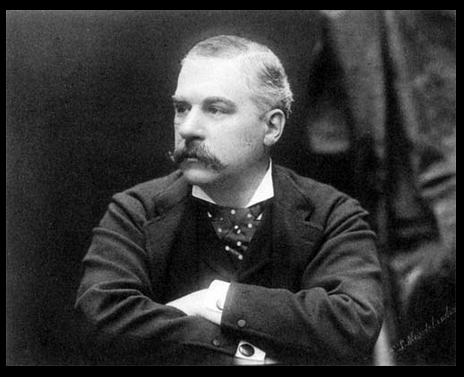
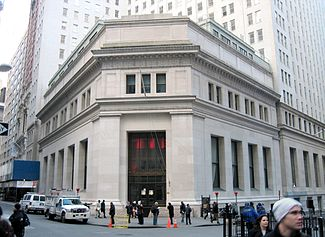

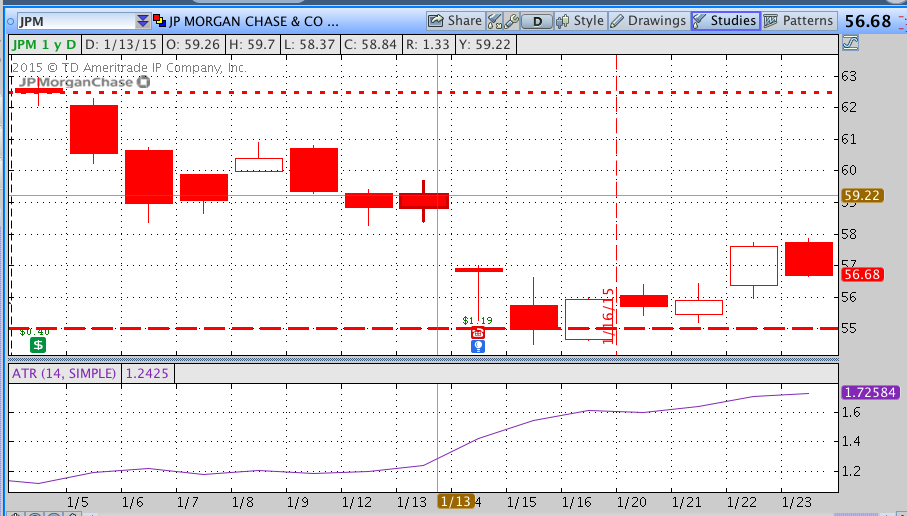
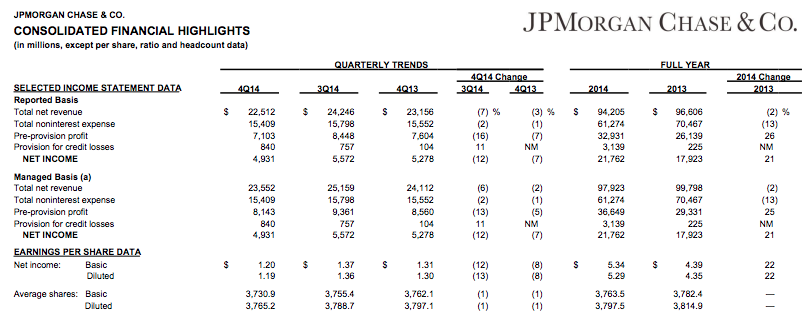



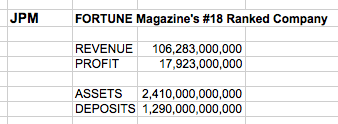
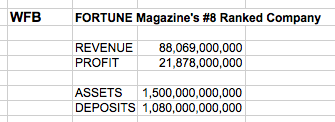
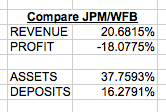

 2 Quantum Computing Stocks That Could Supercharge Your Portfolio
2 Quantum Computing Stocks That Could Supercharge Your Portfolio
